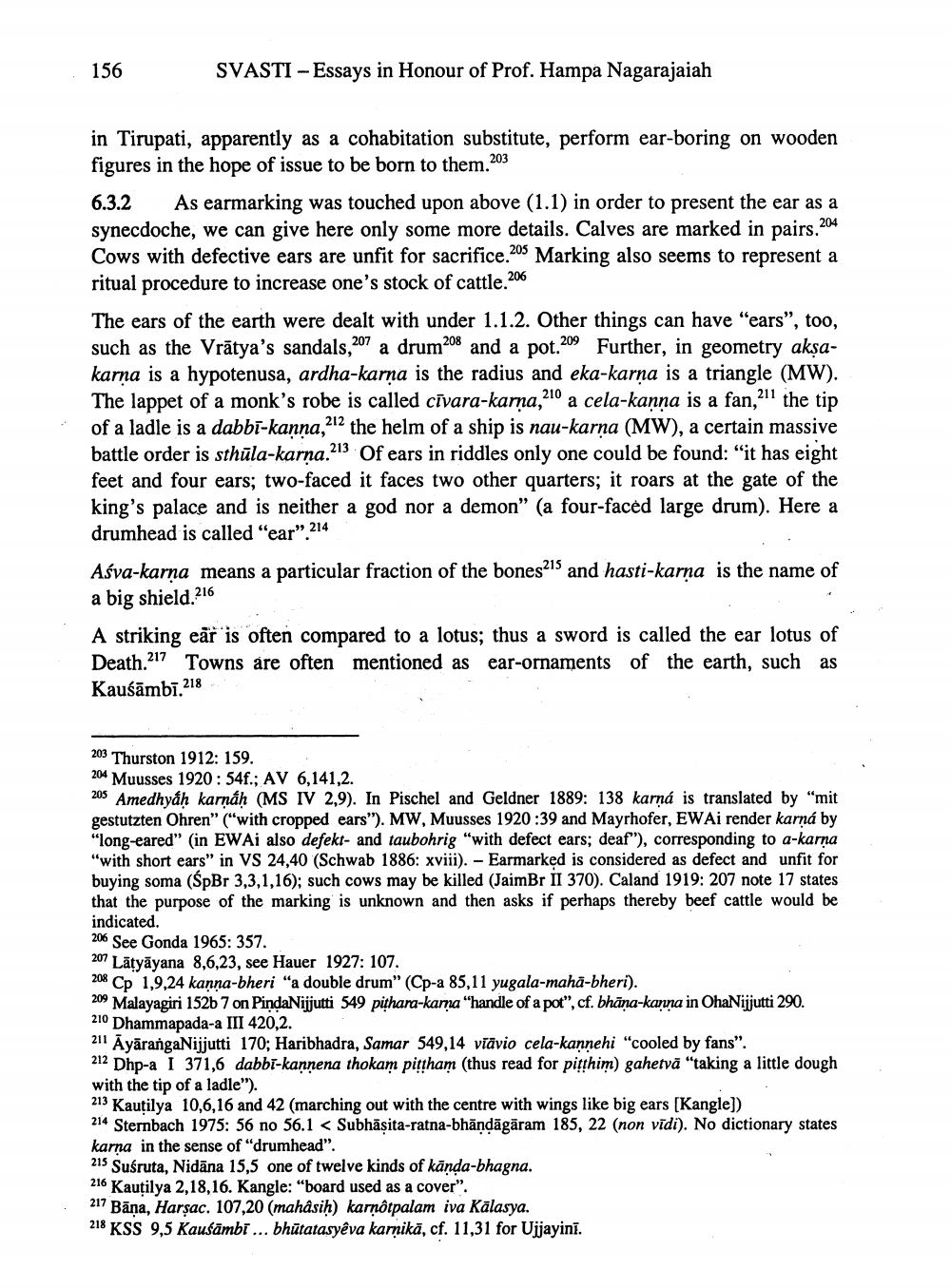________________
156
SVASTI - Essays in Honour of Prof. Hampa Nagarajaiah
in Tirupati, apparently as a cohabitation substitute, perform ear-boring on wooden figures in the hope of issue to be born to them.203 6.3.2 As earmarking was touched upon above (1.1) in order to present the ear as a synecdoche, we can give here only some more details. Calves are marked in pairs.204 Cows with defective ears are unfit for sacrifice.205 Marking also seems to represent a ritual procedure to increase one's stock of cattle.206 The ears of the earth were dealt with under 1.1.2. Other things can have "ears”, too, such as the Vrātya's sandals,207 a drum208 and a pot.209 Further, in geometry akşakarna is a hypotenusa, ardha-karna is the radius and eka-karna is a triangle (MW). The lappet of a monk's robe is called cīvara-karna,210 a cela-kanna is a fan,211 the tip of a ladle is a dabbi-kanna,212 the helm of a ship is nau-karna (MW), a certain massive battle order is sthūla-karna 213 Of ears in riddles only one could be found: "it has eight feet and four ears; two-faced it faces two other quarters; it roars at the gate of the king's palace and is neither a god nor a demon" (a four-faced large drum). Here a drumhead is called "ear” 214 Ašva-karna means a particular fraction of the bones21s and hasti-karna is the name of a big shield 216 A striking ear is often compared to a lotus; thus a sword is called the ear lotus of Death.217 Towns are often mentioned as ear-ornaments of the earth, such as Kauśāmbī.218
en Myhedhyāḥ karşâh (MSropped cars"). Mw. Nie with gestutzten Ohren"WAI also defekt-wand 1986: xviil). -- Earmark i 370).
eaf”), co as defecy note 17.uld
203 Thurston 1912: 159. 204 Muusses 1920: 54f.; AV 6,141,2. 205 Amedhyâh karnáh (MS IV 2,9). In Pischel and Geldner 1889: 138 karņá is translated by "mit gestutzten Ohren" ("with cropped ears"). MW, Muusses 1920:39 and Mayrhofer, EWAi render karná by "long-eared" (in EWAI also defekt- and taubohrig "with defect ears; deaf"), corresponding to a-karna "with short ears" in VS 24,40 (Schwab 1886: xviii). - Earmarked is considered as defect and unfit for buying soma (ŚpBr 3,3,1,16); such cows may be killed (JaimBr II 370). Caland 1919: 207 note 17 states that the purpose of the marking is unknown and then asks if perhaps thereby beef cattle would be indicated. 206 See Gonda 1965: 357. 207 Lätyāyana 8,6,23, see Hauer 1927: 107. 208 Cp 1,9,24 kanna-bheri "a double drum" (Cp-a 85,11 yugala-mahā-bheri). 209 Malayagiri 152b 7 on PindaNijjutti 549 pithara-kamna "handle of a pot", cf. bhāņa-kanna in OhaNijjutti 290. 210 Dhammapada-a III 420,2. 211 ĀyārangaNijjutti 170; Haribhadra, Samar 549,14 viāvio cela-kannehi "cooled by fans". 212 Dhp-a I 371,6 dabbi-kannena thokam pittham (thus read for pithim) gahetvā "taking a little dough with the tip of a ladle"). 213 Kautilya 10,6,16 and 42 (marching out with the centre with wings like big ears [Kangle)) 214 Sternbach 1975: 56 no 56.1 < Subhāṣita-ratna-bhāndāgāram 185, 22 (non vidi). No dictionary states karna in the sense of "drumhead". 215 Suśruta, Nidāna 15,5 one of twelve kinds of kända-bhagna. 216 Kautilya 2,18,16. Kangle: "board used as a cover". 217 Bāna, Harsac. 107,20 (mahâsih) karnôtpalam iva Kalasya. 218 KSS 9,5 Kaušāmbi ... bhūtatasyêva karnikā, cf. 11,31 for Ujjayinī.




